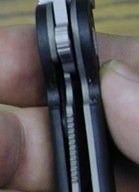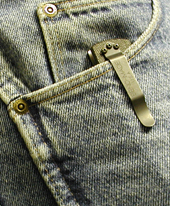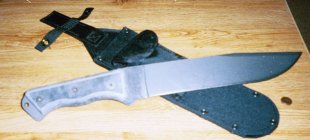its paid sponsors, whose products you need!
“Stay ‘unreasonable.’ If you
don’t like the solutions [available to you], come up with your
own.”
Dan Webre
The Martialist does not
constitute legal advice. It is for ENTERTAINMENT
PURPOSES ONLY.
Copyright © 2003-2004 Phil Elmore, all rights
reserved.
Knife Basics
By Phil Elmore
Knives are among the most important of tools created by human beings.
They are also extremely effective weapons. While the topic may seem
complex to those not familiar with blades, their uses, their specific
terminology, and their training, anyone can learn to use and enjoy knives.
The purpose of these knife tutorials at The
Martialist is to get the beginner up to speed on the topic. If
you know nothing about knives but think you should be carrying one, these
are a good place to start. While no article (and no series of
articles) can cover everything, our assumption is that you wish to select
and carry (on a regular basis) a blade of some kind as part of your daily
accessories. You may intend to use your knife for utility, as a
self-defense tool, or both.
Before we begin, no discussion of knives can take place without
spending a little time on
knife laws. I am not a lawyer
and cannot advocate specific actions, so don’t take my word for anything
you read about knife legislation. Much myth and
misinformation abounds regarding laws that restrict possession and carry
of knives, primarily at the state level. Your state’s penal code is
the best source of information on knife laws.
Do not ask a police officer, a court representative, or anyone
else, because you’ll get as many different answers as you ask questions.
(Police officers are often quite ignorant of the details of knife laws,
relying on folklore standards like measuring the blade across the palm.)
Find your state’s legislature online and look to see if your penal code is
on the Web. If you can’t find it there,
take a voyage to your local
library and look up your state’s penal code in the reference books
available there. Be prepared to deal with ambiguity, for the laws
quite often are written so broadly that they could outlaw virtually
anything. If your state has a blade length limit, pay special
attention to this.
Contributor Bill Lang wrote the following on
researching knife laws:“Although most knife statutes are so vague that this lawyer often cannot read them and the
case law interpreting them [to] conclusively state whether …a given knife is legal in a given state, there are five things I attempt to find when I research knife laws:“1) Blade length limitations. Is the specified length the maximum legal length or the minimum illegal length?
“2) Double edged permitted, or single-edge only? If it prohibits daggers and dirk knives I assume that means most or all double-edge blades.
“3) Are fixed-blades permitted, or must a knife be a folder?
“4) Are there limits on the circumstances under which certain knives may be
carried for example, only while hunting or fishing?“5) Are there limits on the opening mechanism? Typically (but not universally) switchblades and gravity knives will be prohibited and most other folder designs will be permitted. However, some states may vary in what they classify to be a switchblade (Kershaw assisted opening?) or gravity knife
(butterfly/balisong?).“[If I fail to find] some of the above, I try to get a feel for the circumstances under which people get arrested and convicted for carrying knives in that jurisdiction. Are they getting convicted just for carrying the knife, or were they convicted because they were carrying the knife while
committing a crime (which may or may not have had anything to do with the knife)?“Unfortunately, this really only details the questions to ask, the answers to which will vary considerably.”
There are two basic categories of knives: folders and fixed
blades. A
folder
is
any knife that folds, while a
fixed blade or straight
knife is any knife that does not fold. Knives have a specific
argot
that can seem like a different language to the uninitiated.
Fortunately, there are a number of FAQ files that can help, such as the
rec.knives FAQs on
coating,
geometry,
edges,
multi-tools,
sharpening,
steel,
fullers (“blood grooves”) and liner
locks. AG Russell’s online
Knife Encyclopedia is also a very good source of information.

Rocker-bar locking folder.
The spring,
exposed at the
back of the spine,is pressed to release the lock.
A lockblade,
lockback, or liner lock
folder is a folding knife that locks open when the blade is deployed.
Lockblades and lockbacks traditionally were “rocker bar lock” folders.
A rocker bar lock is released by pressing an exposed portion of the spine
of the knife.
 Liner
Liner
locks, which have become increasingly popular in the past few years, use a
bent, springy piece of metal within the handle that blocks the open blade
and which must be pushed aside to close the knife. A liner lock
allows the knife to be released and closed easily with only one hand,
while a rocker bar lock must be closed with both hands unless you’re
feeling skilled or lucky. Most lockbacks, and particularly most
liner lock folders, can be snapped open with only one hand if you’ve got a
strong wrist and know what you’re doing.
Several companies have introduced proprietary locking systems such as the
compression lock, arc lock, plunge lock, axis lock,
and so forth. These may or may not be improvements on the rocker bar
lock and liner lock mechanisms. I won’t get into the details of
these, except to say that the idea is the same: they provide a means to
lock the blade open in what is (hopefully) a secure fashion.
Mechanisms that permit release of the lock while not placing the fingers
in the path of the closing blade are a plus, in my opinion.

The SOG Pentagon tactical folder, which uses SOG’s Arc Lock.
A tactical folder is a lockblade, lockback, liner lock,
or other locking folder with a couple of modern features (which have
become popular since the late 80’s or early 90’s). One feature is a
thumb hole in the blade (or a thumb stud or disk affixed to the blade)
that allows the knife to be opened easily with only one hand by using the
thumb or index finger to push the blade open.

Typical tactical folder: CRKT M16.
The thumb stud is clearly visible.
 Another
Another
feature (not always, but usually present on “tactical folders”) is a
pocket clip a metal or plastic spring clip like that found on a
pager, which allows the knife to be clipped inside a waistband or pocket.
As I write this, tactical folders (because they are easily opened and can
be clipped just about anywhere) are monstrously popular among Knife
People. They are intended as general utility knives, but are also designed
to function as last-resort self defense implements, which probably
explains their wide popularity.
A balisong or
butterfly knife is a Filipino folding knife often seen in martial arts
movies. (While the design may not actually originate with the Filipinos,
the balisong is undeniably tied to Filipino culture.) The knife consists
of a pair of handle halves that rotate 180 degrees to cover the blade.
Skilled practitioners of the balisong can open and close the blade with
one hand, flashing the handle halves back and forth in an impressive
series of movements. Because of their fearsome and exotic mystique,
butterfly knives are often banned. Because of the spinning motion of the
handle halves, butterfly knives are sometimes classified as gravity
knives, even though this is incorrect.
A
gravity
knife is a knife that uses gravity to deploy the blade. Most
often, it consists of a vaguely cylindrical handle with a hole in the
front, from which the blade deploys when a button is pushed. The knife
must be held pointed down for the blade to fall into place, although a
smart snap of the wrist can flick the blade into position if done
correctly.
A
switchblade
is any knife whose blade opens through spring pressure when a button or
lever is pressed. The term “switchblade” is sometimes used specifically
for Italian-style spring-driven stiletto knives, as opposed to
automatic knife, a term used for any spring-driven blade. (A
stiletto
is actually a fixed-blade stabbing implement that may or may not have a
sharpened edge, but the term is commonly applied to Italian-style
switchblades.) Switchblades do not open appreciably faster than a
tactical folder with a thumb stud, however, and their mechanisms are often
much weaker and prone to malfunction than those of a sturdy locking
folder. Further complicating matters is the existence of
lockback knives
designed to look like Italian-style stiletto switchblades.
A
Bowie
knife is usually defined as a large, clip-point, single-edged
hunting knife. Bowie knives are usually fixed blades rather than folders,
although I have seen some large folding knives labeled “folding bowies.”
The Bowie knife was popularized by American Jim Bowie, and might have been
designed by his brother, Rezin. There is much debate about what the first
Bowie knife actually looked like (it may have been a clip-point blade,
which is a traditional hunting pattern, or it may have been an “Arkansas
tooth pick” pattern, which is a large, symmetrical, double-edged blade),
but it is believed that Bowie killed another man with it during a famous
duel.

Ontario’s RTAK not truly a “Bowie
Knife,”
but similar in concept, size, and shape.
A
dagger is a knife with a double-edged blade
that is,
a blade that is sharpened on both sides. A
dirk is a
knife shaped much like a dagger, but with a blade that is sharp on one
side only. The terms “dagger” and “dirk” ‘are often used as synonyms, and
the definitions of what a dirk and dagger are can be unclear. Most
localities have some sort of law prohibiting the possession of a dirk,
dagger, or stiletto; in these instances the term “stiletto” is used to
mean a long, thin stabbing blade, but may refer (inaccurately) to an
Italian-style switchblade.

Cold Steel Tai Pan, an excellent dagger.
A
neck knife is
any of countless knives of different sizes designed to be worn on a chain
or cord around the neck, typically under the shirt for concealment.
A
multi-tool is any
of several folding tools on the market. Typically equipped with a
knife blade, screwdriver heads, and pliers, these are very popular among
people who like to be prepared for any mechanical problem that pops up.
A live blade is a sharp metal blade. The term
“live” is used to distinguish real knife blades from dull
trainers.
Now that you know a little of the lingo and a few of the
concepts, you’re ready to move on to the other knife tutorials here at
The Martialist‘s archives. Remember that two things make a knife
useful: the edge and the point. An edge cuts things and
people. The point punctures things and people.
If the information contained in this article seems like
too much to process, don’t worry. As with any subject, one becomes
familiar with the world of knives through time and practice. Very
few people who discover the joy of knives stop at buying just one.
As you spend more time involved with
blades, your knowledge of them will grow accordingly.
